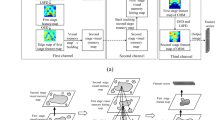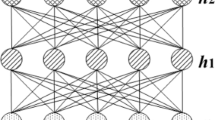Abstract
In this paper, we present a simple yet powerful visual memory model called Increment Pattern Association Memory Model to achieve increment learning and rapid retrieval of visual information. We extend the basic pattern association network by learning patterns based on Leabra framework which combines error-driven learning and Hebbian learning together. In the proposed model, image features act as conditioned stimulus and class labels act as unconditioned stimulus. Increment Learning is achieved by assigning individual synaptic weight to different categories. Meanwhile, k-winners-take-all inhibitory competition function is employed to achieve sparse distributed representations. In addition, normalized dot product is used to realize rapid recall of visual memory. To evaluate the performance of the proposed model, we conduct a series of experiments on three benchmark datasets using three feature-extraction methods. Experimental results demonstrate that the proposed model has a compelling advantage over some prevalent neural networks such as SOINN, BPNN, Biased ART and Self-supervised ART.







Similar content being viewed by others
References
Fei-Fei L, Perona P (2005) A bayesian hierarchical model for learning natural scene categories. In: IEEE computer society conference on computer vision and pattern recognition, vol 2. IEEE, pp 524–531
Cisek P, Drew T, Kalaska J (2007) Computational neuroscience: theoretical insights into brain function. Elsevier, Amsterdam
Tao D, Li X, Wu X, Maybank SJ (2009) Geometric mean for subspace selection. IEEE Trans Pattern Anal Mach Intell 31(2):260–274
Albus JS (2010) A model of computation and representation in the brain. Inf Sci 180(9):1519–1554
Kirkpatrick J, Pascanu R, Rabinowitz N, Veness J, Desjardins G, Rusu AA et al (2017) Overcoming catastrophic forgetting in neural networks. Proc Natl Acad Sci USA 114(13):3521–3526
Dean T (2005) A computational model of the cerebral cortex. In: National conference on artificial intelligence. AAAI Press, pp 938–943
Norman KA, O’Reilly RC (2003) Modeling hippocampal and neocortical contributions to recognition memory: a complementary-learning-systems approach. Psychol Rev 110(4):611–46
Hattori M (2014) A biologically inspired dual-network memory model for reduction of catastrophic forgetting. Neurocomputing 134:262–268
Sakurai N, Hattori M, Ito H (2002) SOM associative memory for temporal sequences. In: International joint conference on neural networks, vol 1. IEEE, pp 950–955
Grossberg S (2013) Adaptive resonance theory: how a brain learns to consciously attend, learn, and recognize a changing world. Neural Netw 37(1):1–47
Yu J, Rui Y, Chen B (2014) Exploiting click constraints and multi-view features for image re-ranking. IEEE Trans Multimed 16(1):159–168
Yu J, Tao D, Wang M, Rui Y (2015) Learning to rank using user clicks and visual features for image retrieval. IEEE Trans Cybern 45(4):767–779
Yu J, Rui Y, Tao D (2014) Click prediction for web image reranking using multimodal sparse coding. IEEE Trans Image Process 23(5):2019–32
Hong C, Yu J, Tao D, Wang M (2015) Image-based three-dimensional human pose recovery by multiview locality-sensitive sparse retrieval. IEEE Trans Ind Electron 62(6):3742–3751
Su Y (2017) Robust video face recognition under pose variation. Neural Process Lett 1–15. https://doi.org/10.1007/s11063-017-9649-8
Liu W, Tao D, Cheng J, Tang Y (2013) Multiview hessian discriminative sparse coding for image annotation. Comput Vis Image Underst 118(1):50–60
Tao D, Li X, Wu X, Maybank SJ (2007) General tensor discriminant analysis and gabor features for gait recognition. IEEE Trans Pattern Anal Mach Intell 29(10):1700–1715
Yu J, Zhang B, Kuang Z, Lin D, Fan J (2017) Iprivacy: image privacy protection by identifying sensitive objects via deep multi-task learning. IEEE Trans Inf Forensics Secur 12(5):1005–1016
Yu J, Yang X, Gao F, Tao D (2016) Deep multimodal distance metric learning using click constraints for image ranking. IEEE Trans Cybern PP(99):1–11
Hong C, Yu J, Wan J, Tao D, Wang M (2015) Multimodal deep autoencoder for human pose recovery. IEEE Trans Image Process 24(12):5659–5670
Palm G (2013) Neural associative memories and sparse coding. Neural Netw 37:165–171
Rolls ET (2016) Cerebral cortex: principles of operation. Oxford University Press, Oxford
Rolls ET, Treves A (1998) Neural networks and brain function. Oxford University Press, Oxford
O’Reilly RC, Munakata Y, Frank MJ, Hazy TE (2012) Computational cognitive neuroscience, 1st edn. Wiki Book, New York
Yang J, Yu K, Gong Y, Huang T (2009) Linear spatial pyramid matching using sparse coding for image classification. In: IEEE conference on computer vision and pattern recognition (CVPR 2009). IEEE, pp 1794–1801
Wang Y, Deng L (2016) Modeling object recognition in visual cortex using multiple firing k-means and non-negative sparse coding. Signal Process 124:198–209
Simonyan K, Zisserman A (2014) Very deep convolutional networks for large-scale image recognition. arXiv preprint arXiv:1409.1556
Hebb DO (1949) The organization of behavior: a neuropsychological theory. Wiley, New York
Liu W, Zha ZJ, Wang Y, Lu K, Tao D (2016) p-Laplacian regularized sparse coding for human activity recognition. IEEE Trans Ind Electron 63(8):5120–5129
O’Reilly RC, Munakata Y (2000) Computational explorations in cognitive neuroscience: understanding the mind by simulating the brain. MIT Press, Cambridge
Ketz N, Morkonda SG, O’Reilly RC (2013) Theta coordinated error-driven learning in the hippocampus. PLoS Comput Biol 9(6):e1003067
Amis G, Carpenter G (2009) Self-supervised ARTMAP. Neural Netw 23:265–282
Carpenter GA, Gaddam SC (2010) Biased ART: a neural architecture that shifts attention toward previously disregarded features following an incorrect prediction. Neural Netw 23:435–451
Shen F, Hasegawa O (2006a) An incremental network for on-line unsupervised classification and topology learning. Neural Netw 19:90–106
Sadeghi BHM (2000) A BP-neural network predictor model for plastic injection molding process. J Mater Process Technol 103(3):411–416
Vehtari A, Lampinen J (2000) Bayesian MLP neural networks for image analysis. Pattern Recognit Lett 21(13–14):1183–1191
Chang C, Lin C (2011) LIB-SVM: a library for support vector machines. ACM Trans Intell Syst Technol 2(3):1–27
Norman KA (2010) How hippocampus and cortex contribute to recognition memory: revisiting the complementary learning systems model. Hippocampus 20(11):1217–1227
Vanhoucke V, Senior A, Mao MZ (2011) Improving the speed of neural networks on CPUs. In: Proc. deep learning and unsupervised feature learning NIPS workshop, vol 1, pp 1– 4
Werner GÁ, Hanka L (2016) Tuning an artificial neural network to increase the efficiency of a fingerprint matching algorithm. In: 2016 IEEE 14th international symposium on applied machine intelligence and informatics (SAMI). IEEE, pp 105–109
Han S, Liu X, Mao H, Pu J, Pedram A, Horowitz MA et al (2016) Eie: efficient inference engine on compressed deep neural network. Acm Sigarch Comput Archit News 44(3):243–254
Acknowledgements
The paper is funded by the National Natural Science Foundation of P. R. China (No. 61671480) and the Natural Science Foundation of Shandong Provence (No. ZR2017MF069).
Author information
Authors and Affiliations
Corresponding author
Rights and permissions
About this article
Cite this article
Deng, L., Gao, M. & Wang, Y. Increment Learning and Rapid Retrieval of Visual Information Based on Pattern Association Memory. Neural Process Lett 48, 1597–1610 (2018). https://doi.org/10.1007/s11063-018-9789-5
Published:
Issue Date:
DOI: https://doi.org/10.1007/s11063-018-9789-5




